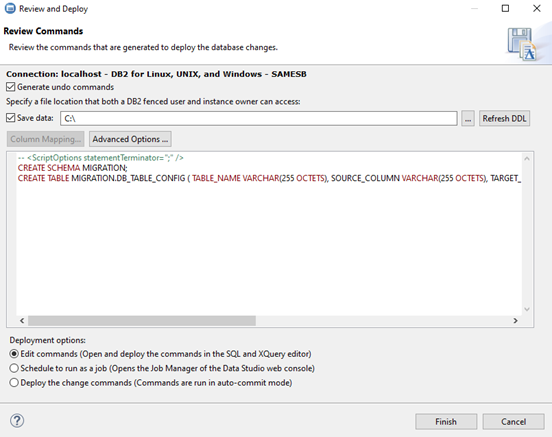
- Db2 command line editor for mac for mac#
- Db2 command line editor for mac install#
- Db2 command line editor for mac drivers#
- Db2 command line editor for mac driver#
- Db2 command line editor for mac password#
clpplus is, because it is a Java application, you need the JRE to use is installed. Here, you can use the clpplus of the required minimum weight.
Db2 command line editor for mac drivers#
Then, of Support IBM Download initial Version 11.1 clients and drivers To do this, there is a download of links to related, such as run-time client. Download initial Version 11.1 clients and drivers will be able to get the packages from the download page of.

Db2 command line editor for mac driver#
This clpplus has been included in the Db2 driver package.
Db2 command line editor for mac install#
The development environment of the Mac, install the clpplus, to connect to an instance of dashDB created in Bluemix, create a table, it will be carried out until you run the Select. By built-in analysis functions and massively parallel processing of dashDB (MPP), you can get an insight into the high speed from the cloud data warehouse of data. It is also possible to mix the column-oriented table and line-oriented table by the database technology of further in-memory. Also if also analyze the stored data in SQL, it can also be analyzed using sophisticated analytics capabilities built, predictive analysis and data mining, analysis by R language, are provided and geospatial analysis you. IBM Db2 The Warehouse on Cloud (nicknamed dashDB)ĭashDB is a DBaaS that combines the analysis function, you can save a relational data, including data of special types, such as geospatial data. IBM Db2 Warehouse on Cloud in this article is described as dashDB as long because the nickname. From the development environment of the Mac, Bluemix to IBM Db2 Warehouse on Cloud of, from the command line tool clpplus, it is what was to organize the information for access by the encryption communication.
Db2 command line editor for mac password#
Enter your SUNetID and Password and an entry will be displayed in the Tokens List.Īt this point you have successfully acquired a Kerberos TGT as well as an AFS token.ORACLE if sqlplus, DB2 if db2, MySQL if mysql, to connect to PostgreSQL if psql, in Bluemix Db2 Warehouse on Cloud (formerly dashDB), No good I do? This memo, which was examined by that. Select the Get new Token button to display a Kerberos authentication dialog box. To use this Preference Pane to manage Kerberos, select the checkboxes for Backgrounder and Use aklog.

When you launch the Preference Pane you will be presented with this screen: This Preference Pane contains options and controls for managing and using Kerberos as well as AFS.
Db2 command line editor for mac for mac#
If the Auristor AFS client for Mac is installed, there will be an addition to System Preferences. A drop-down dialog box for entering your SUNetID and password is displayed.Īfter successful authentication you will see the SUNetID and an expiration date/time. To authenticate (obtain a TGT) click the Add Identity button. When launched, the user is presented with this view: A Ticket Viewer shortcut can be added to the Dock by dragging the app from Finder to the desired location on the Dock. Ticket Viewer is a graphical user interface for the Kerberos system and features buttons for each of the four commands listed in the Overview above. It can be found at: /System/Library/CoreServices/Ticket\ Viewer.app This app is part of the Kerberos subsystem that is included in macOS by Apple. Each of the four commands listed in the Overview above are manually entered into a terminal window and executed. This is the traditional method for managing Kerberos credentials, because Kerberos pre-dates most modern graphical operating systems. This document describes the basic Kerberos-related tasks on both of those tools.

There are two methods for working with Kerberos authentication on macOS: Learn more about Kerberos on macOS and Kerberos at Stanford. It's a somewhat non-standard file name that has been a part of macOS since the beginning. Kerberos is configured for Stanford in a file that is user-installed in /Library/Preferences/. To change your Kerberos password go to Account Manager.

This is also referred to as “acquiring a TGT or ticket-granting ticket."


 0 kommentar(er)
0 kommentar(er)
